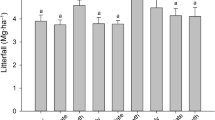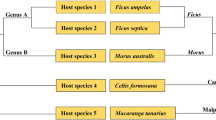Abstract
Fungi are important components of tropical ecosystems, especially in the recycling of nutrients. However, there is little information on how fungal diversity is structured at scales suitable to plan their conservation. We tested if the distribution of fruiting bodies of litter fungi was random in the landscape (over 25 km2) in a tropical evergreen forest in Central Amazonia. We used linear regressions to evaluate the influence of rainfall, soil characteristics and topography on morphospecies richness and composition. Fungi were collected twice in thirty 0.25 × 250 m plots. Short-term rainfall was represented by the cumulative rainfall in the three days before each plot was surveyed. Plots were classified in two groups based on cumulative rainfall. Clay content in soil and rainfall influenced morphospecies richness, but responses to edaphic factors depended on rainfall. Wetter periods apparently decreased limiting moisture conditions in higher areas, allowing fungal activity and fruiting body production. Morphospecies composition was influenced by clay content, but influence on fungi was probably indirect as clay content was correlated with altitude, plant community and nitrogen availability. Our results suggest that the species of litter fungi are not randomly distributed in the landscape. Furthermore, they indicate that it is viable to conduct mesoscale evaluations of fungal diversity, if the temporal and spatial variation and their interaction are taken into account.
Resumo (in Portuguese)
Fungos são importantes componentes dos ecossistemas tropicais, atuando especialmente na reciclagem de nutrientes. Entretanto, existe pouca informação sobre como a diversidade de fungos está estruturada em escalas adequadas para planejar sua conservação. Nós testamos se a distribuição de corpos de frutificação de fungos de liteira ocorre de forma aleatória na paisagem (em 25 km2) em uma floresta na Amazônia Central. Utilizamos regressões lineares para avaliar a influência da precipitação, do solo e topografia sobre a riqueza e composição de morfoespécies. Os fungos foram amostrados em trinta parcelas de 0,25 × 250 m em duas ocasiões. A precipitação em curto prazo foi representada pela chuva acumulada em três dias antes da parcela ser amostrada. As parcelas foram classificadas em dois grupos baseados na precipitação acumulada. O conteúdo de argila no solo e a precipitação influenciaram a riqueza de morfoespécies, mas as respostas aos fatores edáficos dependeram da precipitação. Períodos mais chuvosos aparentemente diminuíram condições limitantes de umidade nas áreas mais elevadas, permitindo a atividade e produção de corpos de frutificação pelos fungos. A composição de morfoespécies foi influenciada pelo conteúdo de argila, mas provavelmente a influência sobre os fungos foi indireta, dado que o conteúdo de argila esteve correlacionado com altitude, comunidade de plantas e disponibilidade de nitrogênio. Nossos resultados sugerem que as espécies de fungos de liteira não estão distribuídas aleatoriamente na paisagem. Além disso, indicam que conduzir avaliações da diversidade de fungos em mesoescala é viável, desde que a variação temporal e espacial, e sua interação, sejam consideradas.



Similar content being viewed by others
Abbreviations
- INPA (Instituto Nacional de Pesquisas da Amazônia):
-
the Portuguese acronym for National Institute of Amazonian Research
- RFAD (Reserva Florestal Adolpho Ducke):
-
the Portuguese acronym for Adolpho Ducke Forest Reserve
- RAPELD:
-
Term coined by Magnusson et al. (2005) applied to their sampling methodology, useful both for rapid access to biodiversity and long-term research
- PELD (Pesquisas Ecológicas de Longa Duração):
-
the Portuguese acronym for Long Term Ecological Research Program
- PPBio (Programa de Pesquisas em Biodiversidade):
-
the Portuguese acronym for Biodiversity Research Program
- COL1:
-
First collection occasion for all plots, from 29 June to 18 September 2005
- COL2:
-
Second collection occasion for all plots, from 20 September to 22 January 2006
- PCoA:
-
Principal Coordinates Analysis
- MR:
-
Morphospecies richness, given by the total number of morphospecies collected
- MC:
-
Morphospecies composition, based on the incidence of morphospecies in each plot
- CPCRH (Coordenação de Pesquisas em Clima e Recursos Hídricos):
-
the Portuguese acronym for Climate and Water Resources Research Coordination
References
Belbin L (1992) PATN: Pattern Analysis Package. CSIRO Division of Wildlife and Ecology, Canberra
Braga-Neto R (2007) Guia de morfoespécies de fungos de liteira da Reserva Ducke. Programa de Pesquisas em Biodiversidade (PPBio/INPA). Available from: http://ppbio.inpa.gov.br/Port/inventarios/guias/Guia_fungos_RFAD.pdf
Cantrell SA (2004) A comparison of two sampling strategies to assess discomycete diversity in wet tropical forests. Caribb J Sci 40:8–16
Chauvel A, Lucas Y, Boulet R (1987) On the genesis of the soil mantle of the region of Manaus, Central Amazonia, Brazil. Experientia 43:234–241
Cornejo FH, Varela A, Wright SJ (1994) Tropical forest litter decomposition under seasonal drought: nutrient release, fungi and bacteria. Oikos 70:183–190
Costa FRC, Magnusson WE, Luizão RCC (2005) Mesoscale distribution patterns of Amazonian understorey herbs in relation to topography, soil and watersheds. J Ecol 93:863–878
Fearnside PM (2006) A vazante na Amazônia e o aquecimento global. Revista Ciência Hoje 39:76–78
Ferraz G, Nichols JD, Hines JE, Stouffer PC, Bierregaard Jr. RO, Lovejoy TE (2007) A large-scale deforestation experiment: effects of patch area and isolation on Amazon birds. Science 315:238–241
Gotelli NJ, Ellison AM (2004) A primer of ecological Statistics. Sinauer Associates, Inc., Massachusetts
Hawksworth DL (1991) The fungal dimension of biodiversity: magnitude, significance, and conservation. Mycol Res 95:641–655
Hawksworth DL (2001) The magnitude of fungal diversity: the 1.5 million species estimate revisited. Mycol Res 105:1422–1432
Hawksworth DL, Colwell RR (1992) Microbial Diversity: biodiversity amongst micro-organisms and its relevance. Biodivers Conserv 1:221–226
Hawksworth DL, Rossman AY (1997) Where are all the undescribed fungi? Phytopathology 87:888–891
Hedger J (1985) Tropical agarics: resource relations and fruiting periodicity. In: Moore D, Casselton LA, Wood DA, Frankland JC (eds) Developmental biology of higher fungi. Cambridge University Press, Cambridge
Kinupp VF, Magnusson WE (2005) Spatial patterns in the understorey shrub genus Psychotria in Central Amazonia: effects of distance and topography. J Trop Ecol 21:363–374
Krebs CJ (1998) Ecological methodology. Benjamin Cummings, New York
Legendre P, Legendre L (1998) Numerical ecology. Elsevier Science BV, Amsterdam
Lodge DJ, Cantrell S (1995) Fungal communities in wet tropical forests: variation in time and space. Can J Bot 73: S1391–S1398
Lodge DJ, Chapela I, Samules G et al. (1995) A survey of patterns of diversity in non-lichenized fungi. Mitteilungen der Eidgenössischen Forschungsanstalt für Wald, Schnee und Landschaft 70:157–173
Lodge DJ, Ammirati JF, O’Dell TE, Mueller GM (2004) Collecting and describing macrofungi. In: Mueller GM, Bills GF, Foster MS (eds) Biodiversity of fungi: Inventory and monitoring methods. Elsevier Academic Press, San Diego
Luizão FJ (1989) Litter production and mineral element input to the forest floor in a Central Amazonian Forest. GeoJournal 19:407–417
Luizão RCC, Luizão FJ, Paiva RQ, Monteiro TF, Sousa L, Kruijt B (2004) Variation of carbon and nitrogen cycling processes along a topographic gradient in a Central Amazonian forest. Global Change Biol 10:592–600
Magnusson WE, Lima AP, Luizão RCC et al. (2005) RAPELD: uma modificação do método de Gentry para inventários de biodiversidade em sítios para pesquisa ecológica de longa duração. Biota Neotropica 5:19–24. Available from: http://www.scielo.br/scielo.php?script=sci_arttext&pid=S1676–06032005000300002&lng=en&nrm=iso
Manly BFJ (1997) Randomization, bootstrap and Monte-Carlo methods in biology. Chapman and Hall, London
Marques-Filho AO, Ribeiro MNG, Santos JM (1981) Estudos climatológicos da Reserva Florestal Ducke, Manaus, AM. IV - Precipitação. Acta Amazonica 4:759–768
McCune B, Grace JB (2002) Analysis of Ecological Communities. MjM Software Design, Oregon
Mertens J (2004) The characterization of selected physical and chemical soil properties of the surface soil layer in the “Reserva Ducke”, Manaus, Brazil, with emphasis on their spatial distribution. Dissertation, Humboldt-Universität Zu Berlin
Mueller GM, Schmit JP, Leacock PR, Buyck B, Cifuentes J, Desjardin DE, Halling RE, Hjorstam K, Iturriaga T, Larsson K-H, Lodge DJ, May TW, Minter D, Rajchenberg M, Redhead SA, Ryvarden L, Trappe JM, Watling R, Wu Q-X (2006) Global diversity and distribution of macrofungi. Biodivers Conserv 16:37–48
O’Dell TE, Lodge DJ, Mueller GM (2004) Approaches to sampling macrofungi. In: Mueller GM, Bills GF, Foster MS (eds) Biodiversity of fungi: Inventory and monitoring methods. Elsevier Academic Press, San Diego
Polishook JD, Bills GF, Lodge DJ (1996) Microfungi from decaying leaves of two rain forest trees in Puerto Rico. J Indust Microbiol 17:284–294
Rayner ADM, Watling R, Frankland JC (1985) Resource relations – an overview. In: Moore D, Casselton LA, Wood DA, Frankland JC (eds). Developmental biology of higher fungi. Cambridge University Press, Cambridge
Redhead SA (1989) A biogeographical overview of the Canadian mushroom flora. Can J Bot 67:3003–3062
Santana M, Lodge DJ, Lebow P (2005) Relationships of host recurrence in fungi to rates of tropical leaf decomposition. Pedobiologia 49:549–564
Schmit JP, Mueller GM, Leacock PR, Mata JL, Wu Q-X, Huang Y-Q (2005) Assessment of tree species richness as a surrogate for macrofungal species richness. Biol Conserv 121:99–110
Schmit JP, Mueller GM (2006) An estimate of the lower limit of global fungal diversity. Biodivers Conserv 16:99–111
Singer R (1976) A Monograph of the Neotropical species of the Marasmieae (excepting the Oudemansiellinae), Basidiomycetes–Tricholomataceae. Flora Neotropica 17:1–347
Singer R (1978) Origins of the deficiency of Amazonian soils––a new approach. Acta Amazonica 8:315–316
Singer R (1986) The Agaricales in modern taxonomy, 4th edn. Koeltz Scientific Books, Koenigstein
Singer R, Araujo IJS (1979). A comparison of litter decomposing and ectomycorrhizal Basidiomycetes in latosol-terra-firme rain forest and white podzol campinarana. Acta Amazonica 9:25–41
Sombroek WG (2000) Amazon land forms and soils in relation to biological diversity. Acta Amazonica 30:81–100
Swift MJ, Heal OW, Anderson JM (1979) Decomposition in terrestrial ecosystems. Oxford Blackwell Publications, Oxford
Swift MJ (1982) Basidiomycetes as components of forest ecosystems. In: Frankland JC, Hedger J, Swift MJ (eds). Decomposer basidiomycetes: their biology and ecology. Cambridge University Press, Cambridge
Trenberth KE, Shea DJ (2006) Atlantic hurricanes and natural variability in 2005. Geophysical Research Letters 33:L120704
Vogt KA, Bloomfield J, Ammirati JF, Ammirati SR (1992) Sporocarp production by Basidiomycetes, with emphasis on forest ecosystems. In: Carroll GC, Wicklow DT (eds) The fungal community, 2nd edn. Marcel Dekker Inc, New York
Wilkinson L (1998). Systat, Version 8.0. SPSS Inc., Chicago
Wood TA, Lawrence D, Clark DA (2006) Determinants of leaf litter nutrient cycling in a tropical rain forest: soil fertility versus topography. Ecosystems 9:1–11
Acknowledgements
Ricardo Braga-Neto acknowledges the support of a Brazilian National Research Council (CNPq) graduate scholarship. Brazilian Long Term Ecological Research (PELD) guaranteed field support and equipment acquisition. The European Network for Research in Global Change (ENRICH) provided support during the preparation of this manuscript. Topographic and edaphic data were obtained from PELD and PPBio (Programa de Pesquisas em Biodiversidade). Eleusa Barros, Tânia Pimentel and Jane Mertens contributed to soil data acquisition. Rainfall data were obtained from CPCRH/INPA (Coordenação de Pesquisas em Clima e Recursos Hídricos). We thank Dennis Desjardin, Carla Puccinelli and Débora Drucker for their contributions; and D. Jean Lodge, Roberto Garibay Orijel and two anonymous reviewers for revising earlier versions of the manuscript.
Author information
Authors and Affiliations
Corresponding author
Rights and permissions
About this article
Cite this article
Braga-Neto, R., Luizão, R.C.C., Magnusson, W.E. et al. Leaf litter fungi in a Central Amazonian forest: the influence of rainfall, soil and topography on the distribution of fruiting bodies. Biodivers Conserv 17, 2701–2712 (2008). https://doi.org/10.1007/s10531-007-9247-6
Received:
Accepted:
Published:
Issue Date:
DOI: https://doi.org/10.1007/s10531-007-9247-6




